Your Guide to Caring for Horses in Winter
December 01, 2023
Your Guide to Caring for Horses in Winter
Winter weather is here once again! As the season welcomes wintry landscapes and cozy nights in, it also brings not-so-welcome bone-chilling temperatures, freezing rain and snow, and icy conditions for you and your horse to navigate.
You want to keep your horses healthy, warm, and safe in winter. We have some suggestions to help you do that! Learn more below about horse care in cold weather and how to reduce icy conditions that pose slip risks for horses.
Quick Content Guide
- Learn how horses adapt and gear up for cold weather
- 6 things horses need owners to do for them during winter
- Get tips to decrease ice around barns, stalls, and trailers
- Pick up an ice melt that’s safe for horses and pets
How Do Horses Stay Warm in the Winter?
Horses are incredible animals, naturally equipped to handle the harsh weather mother nature hurls in winter. As seasons change, temperatures dive, and snow flies, horses increase their natural defenses by:
- Adding extra body fat for warmth
- Growing a thick winter coat that they fluff up to withstand the chill
- Managing blood flow and pooling the majority in their core and vital organs
- Allowing lower legs and hooves, which withstand freezing well, to take the brunt end of the cold
While horses can handle impressive levels of cold, without proper attention, they can suffer and their body condition may backslide during winter. We asked Mike Mumford, a Redmond team member and lifelong equestrian, to offer pointers on cold-weather horse care. Mike lives in high elevation in Utah and has years of experience helping horses comfortably endure harsh winters. His tips are below.
6 Tips for Better Winter Horse Care
After an onslaught of December storms, the snow here in Utah is piled in heaps around pastures and barns, and temperatures are sitting in single digits at night. I really feel for our horses. Even though they adapt well and can cope with frigid temperatures down to -40 °F, they must get cold—which is why we cannot ignore them in winter. Implementing the suggestions below will help your horse tolerate the cold season better.
1. Feeding Horses in Cold Weather
Horses need to eat more in the winter, as cold temperatures burn up more calories, making them less feed-efficient. Expending significant energy staying warm without additional feed will result in a miserable winter and a thinner horse that is less happy and healthy. Horses generate body heat through digestive activity—particularly the fermentation of fiber. Compensate your horse’s extra effort and increase warmth by increasing daily feed rations.
How much to feed a horse in winter
- The average horse needs about 25% more caloric intake during cold months.
How much hay to feed a horse in winter
- Hay is the best feed for most horses in winter. It’s a high-fiber, heat-generating forage that helps them stay warm and maintain body weight. Provide 1.5% to 3% of a horse’s total body weight in forage during cold months. For an average 1,200-lb horse, that equates to 18 to 36 pounds of hay per day.
Redmond Product Tip: Daily Gold provides daily gut support during every season. It balances pH, promotes a healthier microbiome, and optimizes digestion for better feed utilization and year-round weight stability.
2. Provide a Run-In Shed for Horses
A run-in shelter enables horses living out in winter to take refuge and stay dry from driving wind and rainstorms. It also keeps horses warm by helping them conserve 20% more body heat. Keep the shed open so horses can seek shelter when needed and still have the freedom to saunter out and bask in the winter sunshine at will.
Penning them in a stall presents its own issues. Horses need good ventilation, and the air in a barn is often still and cold. There is also less available heat from sunlight. It’s possible during dry, cold conditions that stables (box stalls) are often more chilly than standing outside.
3. Get Horses to Drink More Water in Winter
Winter brings unique challenges for horses, one being a disinclination to drink. With cold weather, horses have little incentive to seek water, and dehydration becomes a significant concern. These tips will help get your horse’s nose in the water bucket even when it’s cold:
- Provide constant access to fresh water between 45-65 °F
- Install a bucket heater or trough deicer to prevent freezing and warm water
- Add a quality loose mineral salt to feed to provide a trigger to drink
- Hang a free-choice mineral salt lick in your horse’s stall or pasture
- Consider occasionally offering electrolytes for horses in winter
Redmond Product Tip: Is your horse drinking less water in winter? Redmond Rock on a Rope, Daily Red Crushed, Daily Red Fortified, and Electrolyte contain salt and full spectrum trace minerals and electrolytes that trigger thirst and help water consumption stay consistent in cold months.
4. Keep Up Winter Hoof Care
Giving hooves proper attention can catch potential problems early and helps horses feel happy and ready to ride come spring. Calendar and be aware of these to-do items for hoof care:
- Ensure horses have a dry place to stand and dry their hooves. Wet hooves lead to rot and infection when left for long periods.
- Pick out hooves and ensure they are clean, with no bacteria or rotting in the crevices of the frog.
- Trim hooves every 6-8 weeks to reduce snowpack and ice balls in horses’ feet and lower slipping risks.
- Remove metal shoes. Going barefoot during winter gives your horse more traction in snow and ice and allows hooves a chance to rest for a few months between shoeing.
- If you keep your horse shod, consider adding studs to the bottom of shoes to increase traction.
Redmond Product Tip: Simply Clay Poultice is a natural and exceptional bentonite clay hoof pack. Its powerful absorption properties draw out moisture and infection and help heal abscesses to keep horses’ hooves healthy year-round.
5. Keep Exercising Horses in Cold Weather
Snow and cold does not have to signal an end to quality time with your horse. Wintertime rides provide an excellent opportunity to give horses attention, check their attitude and demeanor, and maintain good communication and strong relationships. Horses also need regular exercise during winter to:
- Get blood flowing
- Raise body temperature
- Reduce boredom
- Stay fit and healthy
Warm up your horse slowly by walking a minimum of ten minutes before moving into a trot. When you’ve finished riding, cool your horse by walking for ten minutes, then dismount and hand-walk it for several more before removing the saddle. Dry your horse thoroughly before returning to the paddock or stall, as a sweaty horse can catch a chill in cold weather and develop pneumonia or colic.
6. Do Horses Need Blankets in the Winter?
Your immediate instinct may be to blanket your horse when temperatures dip but not all horses need or benefit from a cover. Just place your hand on a horse’s neck under its mane on the coldest mornings, and you will feel it is a radiator of warmth.
That said, some horses absolutely need to be blanketed. So, when should you blanket a horse in winter? Consider the benefits and downsides below, then talk to your vet about the best option for your horse.

Benefits of Blanketing
- Allows horses to keep a short-haired coat if you're showing in cold months
- Provides much-needed warmth for clipped horses
- Helps outside horses stay clean, dry, and ready to ride
- Provides added warmth for horses in extreme-cold situations or without shelter
- Helps horses acclimate from a warm climate to a much cooler climate
Downsides of blanketing
- Prevents horses from growing a thick coat, reducing the ability to regulate body temperature
- Prevents horse hairs from standing up—their natural defense against cold weather
- A blanket that’s too light can cause a horse to become chilled, as blankets compromise natural insulating abilities
- A blanket that’s too heavy can cause horses to start sweating in winter and become chilled
3 Ways to Reduce Ice Around Horses and Barns
While our four-legged friends are nimbler than we are, slipping risks still go up in winter. Freeze-thaw patterns, in particular, create dangerous conditions for horses trying to pick their way across slick stalls, north sides of buildings, and frozen spillover around watering troughs. Incorporate these four suggestions to keep areas from reaching skating-rink status and help horses find solid footing traversing icy ground.
Practice Prevention
First, let’s give our equine friends a little credit. Horses are savvy and will limit activity and avoid icy terrain where they can. But it is up to horse owners to prevent and be on the lookout for icy conditions that horses can’t avoid—like in stalls, trailers, or around feeding and drinking areas.
Here are tips to reduce ice around your facilities:
- Repair leaky rain gutters on barns or buildings that drip and form freezing water.
- Remove snow from high-use pathways and paddocks. (This decreases water buildup and frozen puddles that inevitably appear once things thaw.)
- Avoid water spillage when filling troughs—and fix leaky spigots that drip.
- Build up sunken ground where water collects and pools around troughs.
Roll out the Rugs
Have some old rugs on hand? Turn them into a safe winter walkway. Rugs make for a quick and easy coverlet when you need to lead your horse over an icy patch or out of the stall for turnout time. Keep rugs stashed in the barn for ready access and roll them out when required. Stall mats can also help keep horses safe from frozen liquids on the floor.
Spread the Traction
Stalls and trailers can also get icy and create dangerous situations when hauling horses in cold weather. To minimize risk, scatter on a natural salt or grit. Add traction by applying sand, wood shavings, straw, or a horse-friendly ice melt on floors. Slightly wetting icy surfaces before applying material will improve sticking power and help your horse find firm footing.
Redmond Product Tip: Did you know Redmond has an all-natural deicer? Ice Slicer Nature's Blend is an ice-melting gift from Mother Nature! It’s gentle on surfaces, safe for vegetation, melts faster and longer—and most important, is a horse-safe ice melt.
Summary
Winter can still be a productive time for you and your horse. Following these winter horse care tips will help your horse comfortably endure cold weather, maintain body condition, and be ready to ramp up work when spring arrives. Click below to shop all of Redmond’s natural supplements, including Nature's Blend horse-safe ice melt.
 About the Author: Mike Mumford has ridden many different horses across Europe competing in international modern pentathlon, including for team Great Britain in the 1984 Olympics. For the last 10 years he’s owned a lovely, mistrusting Arabian named Basil. They both reside in Utah, USA.
About the Author: Mike Mumford has ridden many different horses across Europe competing in international modern pentathlon, including for team Great Britain in the 1984 Olympics. For the last 10 years he’s owned a lovely, mistrusting Arabian named Basil. They both reside in Utah, USA.
Learn More
- Don't let wintry weather keep you inside! Get tips for safe winter riding here.
© Redmond Equine 2022. All rights reserved.
Related posts

Winter Horse Riding Tips | Top Picks for Cold Weather Riding Gear
Riding horses in winter is possible and enjoyable! Get tips on working horses in cold weather, staying safe, and what to wear horseback riding in...
December 18, 2024

A Vet's Guide to Feeding & Caring for Horses in Hot Weather
Horse care needs change in hot weather. Get tips for getting your horse in shape, what to feed horses in hot weather, and offering electrolytes to...






